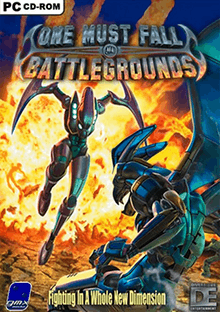One Must Fall: Battlegrounds
| One Must Fall: Battlegrounds | |
|---|---|
 | |
| Developer(s) | Diversions Entertainment |
| Publisher(s) |
Diversions Publishing Trisynergy Inc. GMX Media Manaccom |
| Platform(s) | Microsoft Windows |
| Release | |
| Genre(s) | Fighting |
| Mode(s) | Single-player, Multiplayer (max 16 simultaneously) |
One Must Fall: Battlegrounds is a fighting game for Microsoft Windows. Developed by Diversions Entertainment and co-published in December 2003 by Diversions Publishing and Trisynergy Inc. following nearly 7 years of development, One Must Fall: Battlegrounds brought the One Must Fall series into a second installment released in an age where the gaming world expected graphics and gameplay in three dimensions with internet gameplay an integral portion of the offering.
Background
Battlegrounds started development as a sequel to the popular shareware title One Must Fall: 2097, playing in a side scrolling manner with two opponents facing each other. At the time, Rob Elam saw the opportunity in the Unreal Engine then in development by 2097 publisher Epic MegaGames. At the time, Epic was not yet at a point where they were willing to examine licensing the engine or developing the Unreal Engine for third party use and so a joint decision was reached whereby Rob Elam left to develop a new game engine.
Reception
The game was rated 7.1 by Jeff Gerstmann from GameSpot, noting that the game lacked polish from start to finish, and had much higher system requirements than advertised to achieve a decent frame rate, and even then slow down is noticeable when increasing the resolution. Audio effects were labelled generic and the music was said to sound like it was taken from the Amiga demo scene.[1]
1UP rated the game D+ for lacking real story in story mode, overdone music, average graphics, small range of moves, button-mashing style fighting, and a large speed penalty for multiplayer.[2]
IGN staff member Dan Adams rated the game 6.7 for its low quality animation, mediocre sound effects, problematic game play, large variety of game modes, and lack of online players.[3]